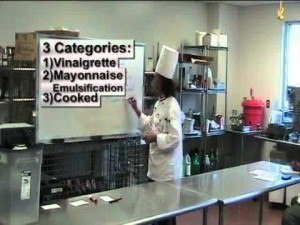It’s a brand new semester in culinary college, and today’s topic is how to make salad dressings. Actually, the focus of the class is “cold sauces”. The semi-liquid that you pour on your greens is no different than any cold sauce, it adds to the appeal of the food.
Any cold sauce has three functions, to flavor, moisten, and enrich. Whether it’s a foundation for salad, a spread for a sandwich, or a cold yogurt sauce on dessert; they serve the same purpose. While making dressings might seem easy, it’s actually more difficult than most cooking techniques, and we’re not even cooking anything!
Salad dressings can be categorized into three segments; oil and vinegar, mayonnaise, and cooked dressings. Each of these is still meant to serve their purpose as flavor, moisture and texture enhancers to the food, but each accomplish this in a different manner.
Oil and vinegar dressings are called vinaigrettes. They consist of only three ingredients. All you need to make an oil and vinegar based dressing is oil, acid, and flavorings. The skill of the chef is choosing the ingredients that compliment each other best. A vinaigrette composed of distilled white vinegar and canola oil will have absolutely no flavor. Instead, a sherry vinegar and walnut oil dressing will be much more interesting.
The major rule when considering how to make salad dressings is that you must ALWAYS use the best ingredients. Sure, there are very few situations that you’d purposely choose the worst ingredients, but it’s especially important with cold sauces because the flavors will not be altered by cooking.
We’ve studied what happens when you apply heat to food in the previous class, “How Does Food Cook?” When you cook something, it undergoes changes. Fats melt, proteins coagulate, vegetables release their moisture, and sugars caramelize. This dramatically changes the flavor and texture of the individual ingredients, an advantage we don’t have with cold sauces.
Since oil and vinegar don’t mix, they have to be forced together. Shaking salad dressing or beating with a whisk creates a temporary emulsion. This process of emulsification is the mixing of two unmixable items. However, with vinaigrettes, it soon separates and the oil floats to the top.
Mayonnaise based dressings are made with a permanent emulsion. We’ll examine this procedure in tomorrow’s class by demonstrating what an egg yolk can do to permanently bring together two unmixable items.
Thickened dressings often use mayonnaise as a base. Ranch dressing is perhaps the most popular salad dressing made this way. Anything called an “aioli” is also a thickened cold sauce because it also uses a permanent emulsification to keep the ingredients consistently mixed.
The third type of salad dressing is called “cooked”. Since we always need cold sauces to actually stick to our food, they need to be thickened. It’s always a disappointment to visit a restaurant and have the flavorful sauce for your salad swim on the bottom of the plate.
Cooked dressings are not hot, but they use the science of “gelatinization of starches” to thicken liquid. By adding a cornstarch slurry to simmering vinegar and flavors, it can be thickened to coat the back of a spoon, and thus stick to your salad.
You’ll know how to make salad dressings that will be unique, flavorful, impressive to your friends, and can’t be found in a grocery store when you know the categories of dressings and the simple three ingredients you need to create your own cold sauces that meet your tastes and desires.
Discover the difference between how professionals and home cooks are taught in my next
FREE Webinar Workshop
Claim your FREE Spot for the next webinar session by CLICKING HERE



Is there any way for Lifetime members to get the free bonuses you offered to new members after this webinar?
Hi Harlene!
Yes, your bonuses are available under the New Members-Get Started Here tab on the top of the home page.